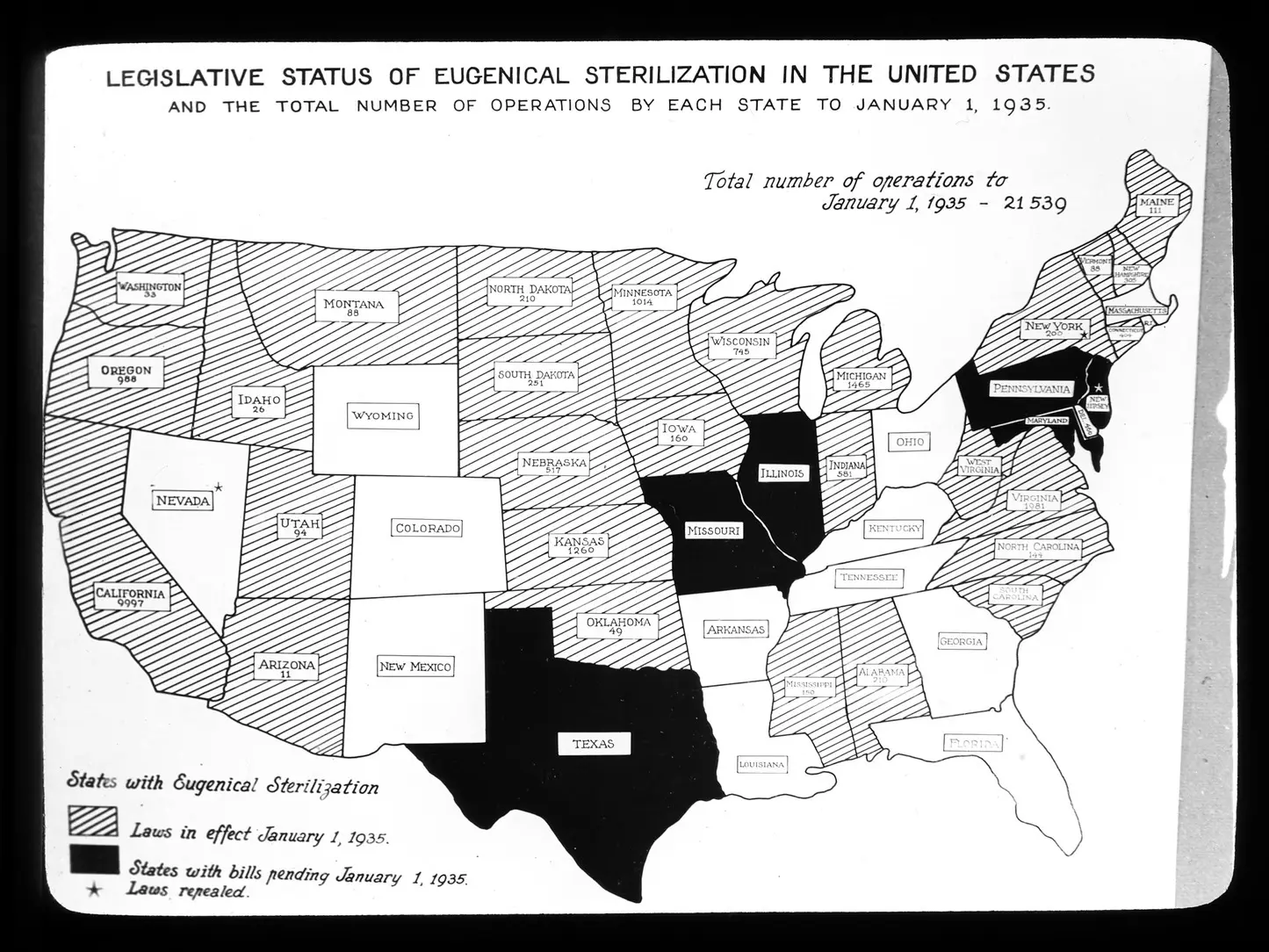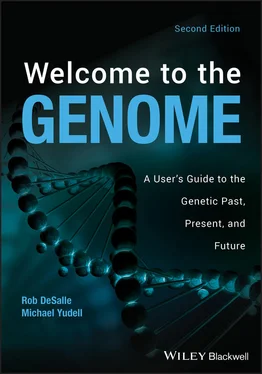Sterilization laws across the United States were also inspired by eugenic sentiment. In the twentieth century at least 60,000 so‐called “feeble‐minded” and genetically unfit Americans were sterilized “in the name of eugenics.” (49)
Criminals and those accused or convicted of sexual offenses were a primary concern of these eugenic laws. In 1907, the state of Indiana established the first sterilization law. By the early 1930s more than 29 other states had passed similar laws. (50) Advocates of criminal sterilization wrote that “criminals should be studied for evidence of dysgenic traits that are germinal in nature. Where found in serious degree parole should not be granted without sterilization.” (51) “Criminality,” “feeble‐mindedness,” and “idiocy” were all traits that eugenicists believed (mistakenly, of course) could be bred out of the species—traits eugenicists believed followed Mendelian patterns of inheritance and could therefore easily be excised. While California and North Carolina had the highest rates during the sterilization period, the last forced sterilization occurred in 1981 in Oregon. (52)
On matters of race, eugenicists were also quite vocal. This period “saw the dominance of the belief that human races differed hereditarily by important mental as well as physical traits, and that crosses between widely different races were biologically harmful.” (53) Well‐respected geneticists wrote openly that “miscegenation can only lead to unhappiness under present social conditions and must, we believe, under any social conditions be biologically wrong.” (54) In this same spirit eugenic racial science became a deviously powerful force in the Third Reich.
Eugenicists also supported racist thought in their claims about the genetic nature of black–white differences. Davenport’s work wasn’t simply a reflection of the racism of his times; his work provided scientific rationale and a language for that racism. For example, Charles Davenport offered his scientific expertise in the study of skin color difference, the application of eugenic doctrines to segregation and anti‐miscegenation laws, and ultimately to the definition of race itself. (55)
It is important to note that Nazi eugenics drew both scientific and ideological inspiration from its American counterpart. Madison Grant’s eugenic tract The Passing of the Great Race: The Racial Basis of European History , which preceded the rise of Nazism by more than a decade, nonetheless influenced German ideas about racial purity. The book, translated into German, explicitly stated, “The laws of nature require the obliteration of the unfit.” (56) American eugenicists themselves highlighted their ties to the Nazis, writing: “To one versed in the history of eugenic sterilization in America, the text of the German statute reads almost like the American model sterilization law.” (57) The ties went even deeper. Philanthropists, including the Rockefeller Foundation, gave grants to German eugenicists even after the rise of Hitler. (58) And even in the wake of mass sterilizations, concentration camps, and gas chambers the support of American eugenicists continued. Support that included a 1935 visiting of Harry Laughlin to the University of Heidelberg where he was acknowledged as “one of the most important pioneers in the field of racial hygiene” (59) and the visit to Berlin in 1935 by Clarence Campbell, head of the Eugenic Research Association. Campbell proclaimed that the Nazi approach to eugenics “sets a pattern which other nations and other racial groups must follow if they do not wish to fall behind in their racial quality, in the racial accomplishments, and in the prospects for survival.” (60) These types of relationships set the stage for the distribution, in the United States in 1937, by American eugenicists, of a Nazi eugenic propaganda film. (61)

Figure 1.7This eugenic map shows an estimate, state by state, of the number of individuals sterilized in the United States through January 1935.
Credit: DNA Learning Center, Cold Spring Harbor Laboratory
After World War II outward support for eugenics became unacceptable to most biologists. The eugenic horrors of the Holocaust all but guaranteed that. And work by prominent geneticists “countered the eugenicists’ simplistic assertions that complex behavioral traits are governed by simple genes.” (62) But even though eugenics as an organized movement ended, eugenic ideas and enactments did not. States and territories like North Carolina and Puerto Rico saw continued sterilizations in the post‐World War II era, (63) and globally, in countries from Mexico to Japan to Iran. (64) Throughout the twentieth century ideas about heredity, social behavior, and human breeding have come in various guises, creating a fear among some that the Human Genome Project could open the door to eugenics once again.
“A VERITABLE ‘AVALANCHE’ OF NUCLEIC‐ACID RESEARCH”
Despite the horrors of eugenics, by the 1930s the ideas of Charles Darwin were once again making headlines as the scientific search for the mechanisms of heredity continued. Darwin’s theory of evolution lacked the mechanism to explain heredity. His theory articulated a “big picture” of evolution. He was right when he explained the ways in which evolution worked, but his theory was incomplete without genetics. Darwin’s theory could not explain how evolutionary traits were passed through time. (65) Evolutionary biologists like R. A. Fisher, J. B. S. Haldane, and Sewell Wright successfully bridged the gap between evolution and genetics and spent their careers developing the mathematical framework for incorporating Mendelian genetics into evolutionary biology. This significant body of work led to what is known as the Modern Synthesis in biology, the merger of Darwinian and Mendelian science. This allowed scientists like Theodosius Dobzhansky, Ernst Mayr, and George Gaylord Simpson, who were based more in data collection than in theory, to develop an empirical approach to evolutionary biology and to open up evolutionary ideas for a broader interpretation in a genetic context. (66)
While the Modern Synthesis provided a framework for understanding questions about heredity in the context of evolution, other scientists were still trying to determine the chemical components of the hereditary material. Some remained wedded to the belief that proteins transmitted traits between generations, among them Hermann Muller, who had originally worked in Thomas Hunt Morgan’s laboratory, whereas others argued that nucleic acids were the fundamental elements of life. (67) No one had been able to prove this either way until a series of ingenious experiments conducted in 1944 by Oswald Avery, Maclyn McCarty, and Colin MacLeod showed that nucleic acids constituted genes. (68)
Working with pneumococcal bacteria, the cause of pneumonia, Avery, McCarty, and MacLeod showed that a benign or harmless strain of pneumococci could be made virulent if mixed with dead bacteria from the same species of pneumococci that were of the virulent type. The benign strain somehow picked up the characteristics of the virulent strain and itself became a deadly form of the bacteria. Just how did this happen? How did the bacterium transform itself? Somehow, a substance in the dead virulent strain was picked up by the active strain. This “transforming principle,” as it became known, altered the bacteria. To show this, the scientists isolated proteins from the virulent strain and mixed them in a laboratory culture with the benign strain. No effect was measured—the bacteria were unchanged. However, when nucleotides from the virulent strain were isolated and mixed with the benign strain, the bacterial culture turned virulent. There it was. They had purified the bacterium’s proteins from its nucleic acids. DNA was the transforming material and the chemical component of genes. One biologist called the findings “electrifying” and became “convinced that it was now conclusively demonstrated that DNA was the genetic material.” (69)
Читать дальше













